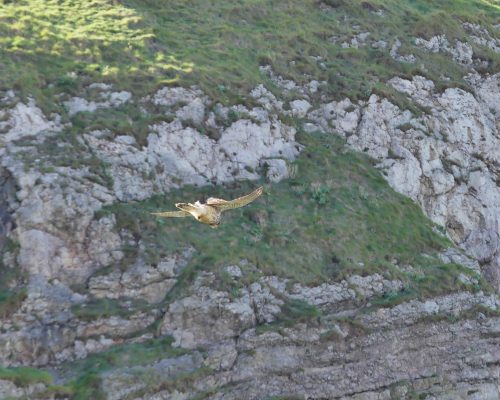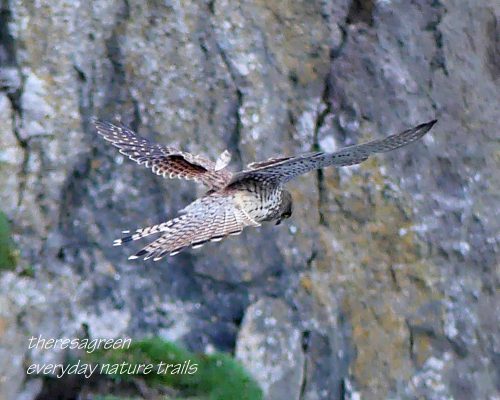Tags
September 15th – Little Orme – Angel Bay
15:00 – Walking towards Angel Bay, it was sunny and eye-squintingly bright but as always of late it felt cool as there was a strong wind blowing in off the sea. Heading for the cliff edge to see if there were any seals about, I was distracted by the sight of a Kestrel hovering almost motionlessly at the edge of the cliff peering intently down. I have had some of my best views of these charismatic little falcons here on the Little Orme, but it’s not every day that you’re graced with such a close presence of one that was clearly totally absorbed in hunting mode and seemingly oblivious to the small audience gathered beneath it.
As I got closer the bird swooped away to land on the rocky cliff to the right of the bay. I tried to get some shots of the landed Kestrel, failing to get the images I’d have liked as I was distracted by a lady asking if I would use my zoom lens to check out the details of a far distant ship! If only I was better at saying no! I did see that the bird had a chestnut head though, which is the colouration of females of the species; males have a blueish-grey head.
Fortunately it didn’t fly far away, just headed for the other side of the bay, now mostly in shade. It suddenly looked small and fragile against the bulk of the cliff, but despite being buffeted by the strong wind it held its position, hardly moving.
Another brief landing then it rose again into the air, hovering in front of us at not much more than eye-level. Perfectly beautiful and an amazing opportunity to see the bird from all angles.
The bird dropped down slightly, showing off the lovely rich chestnut-brown plumage of its back. A similar shade beginning to colour its tail feathers further confirmed this was a female, a young one I think. Young males also have a chestnut head but grey tails and adult males then have both a grey head and tail. Females are slightly larger than males.
Common English name: Kestrel, Common kestrel Scientific name: Falco tinnunculus Welsh: Cudyll coch Local and other names: Windhover, Hoverhawk, Standgale, Creshawk.
The scientific name is taken from the Latin falco = falcom, which translates as sickle, referring to the birds’ hooked talons and the Latin tinnulus, which translates as shrill-sounding. The old country names Windhover, Hoverhawk & Standgale all acknowledge the birds’ unsurpassed mastery of the hovering technique.
The next image is not sharply focussed but I love the way the bird is looking back over her shoulder as if to check if we were all still watching.
HUNTING AND HOVERING TECHNIQUE
A hunting Kestrel typically flies along until it either spots prey or a spot where it is likely to find something. It pauses, then hovers with deeper wing-beats and tail fanned out and pointing downwards for stability; they always keep their head into the wind when hovering. For a few moments the bird remains perfectly motionless in mid-air except for the rapid vibration of its wings. It may then shift its position by a few metres and hovers again, intently scanning every centimetre of the ground below for the slightest movement that may give away the presence of a small rodent; little escapes its telescopic vision. Once prey is detected the bird drops down in stages before making a final pounce and grasping its target with its talons.
During the course of my watching the Kestrel was harassed several times by Jackdaws attempting to drive it away and even by a pair of larger Crows, but she was undeterred and held her position, barely flinching.
CONSERVATION STATUS
Apart from the Game Laws, no measure for the protection of wild birds in Britain existed before the year 1880. Prior to this date, gamekeepers and farmers were responsible for destroying all kinds of birds they suspected as being injurious in any way. Kestrels, along with Barn Owls and Tawny Owls, all of which would have been doing far more good than harm in their controlling of rodents, were accused of taking young Pheasants and therefore on the ‘hit list’ in areas where game birds were reared.
Even twenty years ago the sight of a Kestrel hovering over a motorway verge used to be a fairly common sight, but sadly not so much these days. Drops in Kestrel population figures caused concern in the late 1950s and 1960s when they were reduced to low numbers: changes in farming practices are believed to have been the primary cause. Their numbers have subsequently recovered somewhat and according to the British Trust for Ornithology(BTO), the Conservation Status of the Kestrel in Britain is now Amber and their breeding population is currently estimated at 45,000 breeding pairs. Across the rest of Europe numbers are greater and generally the Kestrel population is currently of ‘Least Concern’.
Kestrels are to some extent migratory. Other than during the breeding season they move from one part of the country to another, and large numbers cross from our southern coasts to Europe and beyond during the winter to be replaced by others that come here from farther north. Despite being a protected species, Kestrels are as vulnerable as any other species of bird on migration that passes over countries still permitted to shoot certain wild birds. As recently as 2015, the hunting season in Malta was brought to an end three days early when a man shot dead a Kestrel.
Maybe the one I watched was here feeding up to make such a journey herself, in which case I wish her safe passage and a safe return next Spring.












A quote from Ted Hughes:
‘Effortlessly at height hangs his still eye / His wings hold all creation in weightless quiet / Steady as hallucination in the streaming air / While banging wind kills those stubborn hedges’
Ted Hughes – The Hawk in the Rain
LikeLike
Fantastic photos of the Kestrel. I have a pair on my local patch but they don’t often stay still enough to get good photos.
LikeLiked by 1 person
Thank you so much. I was lucky to be in the right place at the right time for this rare opportunity; the Kestrel was very obliging and posed beautifully over a good length of time. I only hope she got her reward in the shape of dinner!
LikeLike
Thank you kindly Becky, but the credit must go to the bird for performing so obligingly! I still can’t believe somowone would find a distant passing ship more interesting!
LikeLike
oh wow . . . some of these are superb. So glad it didn’t disappear after that irritating interruption.
LikeLike
Hello Paula, the birds are are beautiful aren’t they? I couldn’t have asked for better views of this one and for once found the strong wind helpful!
LikeLike
Goodmorning Theresa, thanks for the lovely well taken pics of the Kestrel, what a magnificent bird, looked as though it was posing for you.
LikeLiked by 1 person
Interesting photos Theresa, despite you being interrupted to zoom in on the distant ship!! An informative post too, and I loved seeing all the local names listed. They are so descriptive and resonant.
LikeLiked by 1 person
Thank you, I took a lot more photographs as you can imagine but wanted to show as many angles of the bird as possible. I wouldn’t have minded about the interruption if she had been any the wiser about the ship when I showed it to her close up, but she wasn’t! I think it’s a pity the old names drop out of common usage, as you say they are so descriptive and take you back to times when people were far more in tune with the nature around them.
LikeLiked by 1 person
Great photos Theresa. This kestrel could be resident (if only temporarily) on the Little Orme as I’ve spotted a kestrel a few times here lately, as have other walkers (when I’ve been foraging for blackberries, rosehips and elderberries), blackberries now past their best as indicated in your previous blog! As I was picking one evening after work, I shared your story about the Devil spitting on the blackberries with a young grl and her father, saying it was a legend. The girl put me right and said it was a myth, not a legend (Legends are true, Myths are not-they were told that at school). That told me!
LikeLiked by 1 person
Thanks Paul. I too have seen a Kestrel here several times lately but have never got this close before so have no idea if it’s the same one. Other people there that day said they’d seen it successfully hunt, so perhaps it’s found a good spot it returns to. Kids are so sceptical these days! She was right about the myth/legend thing, but who’s to say which it is?! (smiley face).
LikeLike
Superb photos, Theresa. They are stunning birds to watch. 🙂
LikeLiked by 1 person
Thank you Annie, it was an amazing few minutes and a real privilege to be granted such close views. Needless to say, these are just a few of the photos I took!
LikeLiked by 1 person